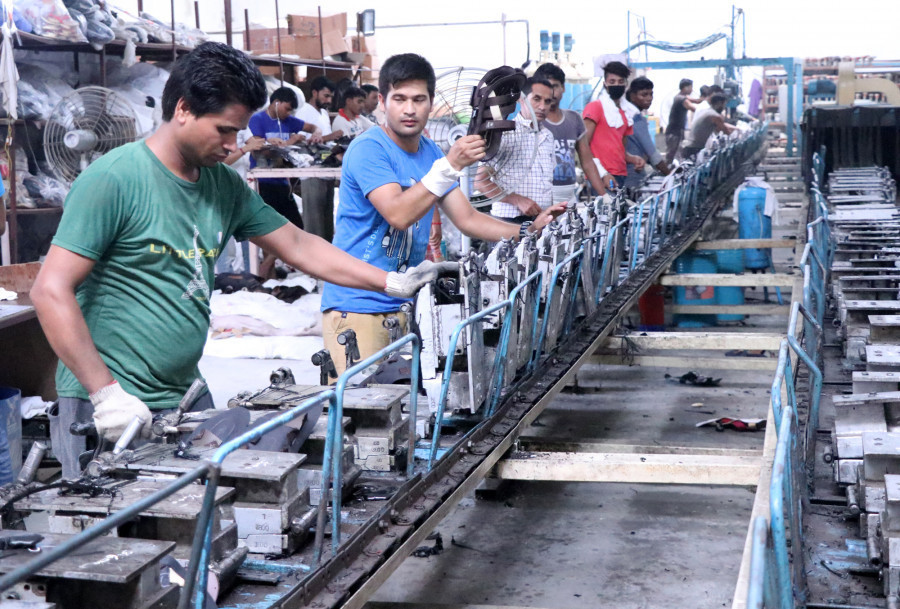Money
Industry gears down following prohibitory orders
The virus caseload has surged in the Tarai plains, the country's industrial heartland. Output is down 50 percent on subdued demand and labour shortage.
Krishana Prasain
Factories are starting to cut output sharply as lockdowns come into place in several areas and the Kathmandu Valley prepares to close from Thursday, in response to the escalating second wave of the Covid-19 pandemic.
The manufacturing sector has received another blow just as it was heading towards recovery following the painful 2020 lockdown and movement restrictions, industrialists said, and if the stay-home order draws out, they will be forced to cut jobs on a massive scale.
According to factory owners in Birgunj and Bhairahawa, production is down by 50 percent on subdued demand and a labour shortage.
Dinesh Shrestha, vice-president (industry) of the Federation of Nepalese Chambers of Commerce and Industry, said the impact of the second wave of Covid-19 has been felt in the country's major industrial hubs.
“The actual data is yet to come in, but the effects of the second wave are clearly evident. Everyone is worried about how long the outbreak will last.”
The virus caseload has surged in the Tarai plains, the industrial heartland of the country. "Output in key production centres like Birgunj and Bhairahawa has declined by 50 percent. Production in Nepalgunj is almost zero which has become a coronavirus hotspot," said Shrestha.
"Factories in Kathmandu and Pokhara are worried about the future,” Shrestha told the Post.
According to the follow-up survey report on the impact of Covid-19 on the Nepali economy published by Nepal Rastra Bank in January, 54 percent of the manufacturers and businesses have resumed full operation.
Industries that were operating at 28.77 percent of capacity had bounced back to 50.51 percent of capacity as of the date of the survey. Employment in the manufacturing sector has also improved from 77.50 percent to 87.51 percent.
“We asked the government to include people employed in industry and in the retail sector in the vaccination drive so that supply would not be disrupted, but it did not happen,” Shrestha said. "If the situation worsens, retailers will not be in a position to take risks," he added.
The business community had urged the government to seal the southern border and suspend flights originating in the immediate neighbour India, which has turned into a near corona disaster zone.
Industrialists said that lockdown cannot be an option as its impact can be negative, not only for the economy but for daily wage earners too.
Mahesh Shah, head of production at Asian Biscuits and Confectionery, said that the second wave of the pandemic had started impacting regular supply of raw materials required for production.
“We import 25 percent of the raw materials for producing biscuits, noodles, confectionery and beverages,” Shah said. Asian Biscuits and Confectionery produces brands like Goodlife Digestive Biscuit, RumPum Noodles, Preeti Noodles, 2PM Noodles, Imli Bomb and Choco Luv.
The company was sourcing its raw materials from India and third countries, but with the second wave severely impacting the southern neighbour, shipments are getting delayed and prices have also increased, he said.
“Besides biscuits, the production of noodles and confectionery has dropped by 50 percent,” said Shah. “But demand for such products, especially biscuits, has increased in the market due to a decline in the illegal entry of biscuits from India.”
The second wave of the pandemic has spread distress among footwear manufacturers as it has come at the height of the peak season when demand from schools and colleges jump, insiders said. The wedding season has also started, but cancelled celebrations means lost sales.
According to Krishna Kumar Phuyal, president of the Footwear Manufacturers Association of Nepal, they are seeing a plunge in demand in the market due to the second wave of the virus that has triggered lockdowns.
“Footwear factories have slashed production in the past 10 days,” he said. “It may fall further.”
As per a central bank report, 96 percent of the factories were shuttered during the lockdown last year. The Covid-19 related lockdown and localised restrictions dragged the economy into negative territory, and it recorded a negative growth of 1.99 percent in the last fiscal year.
According to the Central Bureau of Statistics, in the fourth quarter of the last fiscal year 2019-20 ended mid-July, the country’s economic growth rate, or output of the gross domestic product, plunged 15.4 percent compared to the same period in 2018-19, which resulted in a year-on-year negative growth rate of 1.99 percent.
This is the first annual negative growth rate since 1982-83 when Nepal’s economic growth rate plunged to -2.97 percent, according to the World Bank.
The negative growth rate continued in the first quarter of the current fiscal year 2020-21. The economic growth rate contracted by -4.6 percent in the first quarter of the current fiscal year 2020-21 compared to the same period in 2019-20, owing to localised restrictions even though the lockdown imposed on March 24 was lifted on July 21 last year.
Another survey conducted by the Ministry of Industry, Commerce and Supplies from November 2 to December 1 in the last year on 37 businesses showed that 89.19 percent of firms were operating partially, while 10.81 percent had closed completely. Among the firms that shut down, 75 percent were small and micro enterprises.




 11.12°C Kathmandu
11.12°C Kathmandu















